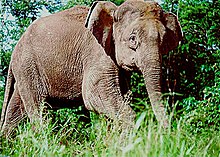Borneo elephant
| Borneo elephant | |
|---|---|
 |
|
| Scientific classification | |
| Kingdom: | Animalia |
| Phylum: | Chordata |
| Class: | Mammalia |
| Order: | Proboscidea |
| Family: | Elephantidae |
| Genus: | Elephas |
| Species: | E. maximus |
| Subspecies: | E. m. borneensis |
| Trinomial name | |
|
Elephas maximus borneensis Deraniyagala, 1950 |
|
The Borneo elephant, also called the Borneo pygmy elephant, inhabits northeastern Borneo, in Indonesia and Malaysia. Its origin remains the subject of debate. A definitive subspecific classification as Elephas maximus borneensis awaits a detailed range-wide morphometric and genetic study. Since 1986, Elephas maximus has been listed as Endangered on the IUCN Red List as the population has declined by at least 50% over the last three generations, estimated to be 60–75 years. The species is pre-eminently threatened by habitat loss, degradation and fragmentation.
The Sultan of Sulu introduced captive elephants to Borneo in the 18th century, which were released into the jungle. Comparison of the Borneo elephant population to putative source populations in DNA analysis indicates that the Borneo elephants are derived from Sundaic stock and indigenous to Borneo. The genetic divergence of Borneo elephants warrants their recognition as a separate evolutionarily significant unit.
In general, Asian elephants are smaller than African elephants and have the highest body point on the head. The tip of their trunk has one finger-like process. Their back is convex or level.
It has become commonplace to refer to Borneo elephants as a ‘pygmy’ subspecies, although adult elephants of Sabah of both genders are similar in height to their counterparts in Peninsular Malaysia. Five measurements of the skull of a fully adult female elephant from Gomantong Forest Reserve were slightly smaller (72 – 90%) than comparable dimensions averaged for two Sumatran skulls. Few available measurements show that they are of similar size to other populations of the Sunda subregion.
Morphological measurements of fifteen captive elephants from Peninsular Malaysia and of six elephants from Sabah were taken between April 2005 and January 2006, and repeated three times for each elephant and averaged. There was no significant difference in any of the characters between the two captive populations.
...
Wikipedia
